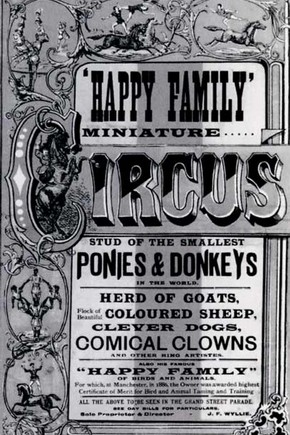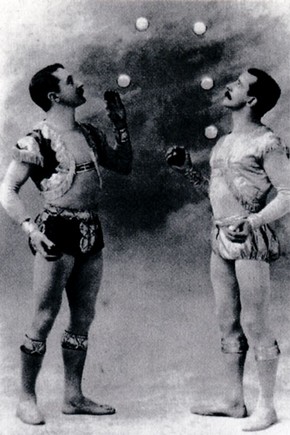Conservation Journal
July 1995 Issue 16
Placement at the Theatre Museum
One of the main conclusions drawn from the two-day residential meeting held by the Department last year in Sussex was the need for greater integration between the Conservation Department and the rest of the V&A. Hence, when the opportunity arose to spend a week with another part of the Museum it seemed a good idea to experience life outside the Department. This was a reciprocal offer made after a member of the Theatre Museum's staff had spent a week working in Conservation.

Fig.1. Bill advertising J.F. Wylie's 'Happy Family' Miniature Circus, Printed by Stafford & Co. Nottingham, late 19th century. Museum No. AHC 2.40 S. (click image for larger version)
The Theatre Museum opened in the spring of 1987 in premises in the heart of theatreland at Covent Garden. A huge variety of live entertainment memorabilia forms the Museum's collections which are, if the Reading Room usage is any indication, in great demand by students, researchers, and members of the general public from all over the world.
This specialised branch museum is a microcosm of the V&A with all its attendant problems of lack of space, staff and money, often seemingly magnified. One general office houses the curatorial, education, marketing and secretariat sections who work cheek-by-jowl in surprising equanimity. One stoic remarked that at least it saved on the number of organised meetings or telephone calls!
The Archive area contains a vast repository of books, theatre programmes, designs, prompt copies, magazines and news cuttings relating to all things theatrical. These will soon be joined by the video archive or National Archive of Stage Performance, which records 'live' performance in a format whereby three different camera angles can be played back simultaneously for a 'truer' record of the overall production. Next to the Archive area is the Reading Room, a brick-vaulted cellar which was originally a vegetable warehouse. This room accommodates around 14 visitors a day but the Museum often has to turn away the same number of would-be users for lack of space.
These were the 'back-stage' areas I visited during my time at the Museum and where I found an attitude of generosity of time and assistance that was uniform throughout this small, tight-knit workforce.
A timetable was drawn up to give me as wide an insight as possible into the workings of this busy museum. The first day passed very quickly, starting with introductions to staff and attendance at a curatorial meeting, followed by an afternoon tour with other V&A staff on an induction course.
The tour took in the galleries, archive reading room and the theatre workshop area. It was said that the Museum had not been originally designed with a theatre of its own, and that the planned lecture theatre was adapted for performances and workshops.
An afternoon spent with the Education Section was as enjoyable as it was enlightening. This Section organises events not just for school children and students of drama, but for tourist groups and other visitors. During the Induction Course tour, a group of young student directors were using the theatre workshop, while the next day a party of middle-aged tourists Were, encouraged to try on hats and costumes borrowed from the Royal Opera House and the National Theatre. This short 'dress rehearsal' helped to explain the meaning of costume's historical status and contribution to the production, and was intended to make the tourist group's subsequent trip around the collections more interesting and lively. The stage make-up demonstration in the Slap! exhibition enhanced this - one participant showing off a gruesomely realistic 'wound' with great relish.
Education were working with the Marketing Section to produce the new Museum leaflet. In two parts, it was to consist of a long-term folded sheet advertising the Theatre Museum generally, with a changeable insert which could promote current events without too much strain on the budget. This has since been superceded by a quarterly, more detailed, folded sheet.
Marketing were also researching a database of companies, travel agents and coach hire companies who might be encouraged to include the Museum in their particular branch of tourism or entertainment. I spent a day being given an insight into the ways and means of promoting an institution which, like all of its kind in the present economic climate, is expected to make income generation a priority.

Fig.2. Alfred John Clarke and John Frederick Clarke juggling balls, about 1895. Museum no. 4.705. (click image for larger version)
Wednesday was spent at Blythe House where the Theatre Museum stores the large majority of its vast archives of posters, costumes and other two- and three-dimensional works. I spent the morning changing the location markings on designs in the Hippisley Coxe Collection of mainly nineteenth century circus memorabilia. Anthony Hippisley Coxe (1912-1988), the self-described 'journalist and critic' was an avid circus enthusiast, and a great friend and supporter of the Theatre Museum.
Publishing works on ghosts, smugglers and the sausage, he sounds as colourful as the objects he collected and on which he was so knowledgeable.
During the afternoon I worked on sorting posters from the Brixton Empress music hall from the first half of this century. This is part of a mammoth ongoing project which involves completely re-housing the posters, interleaving on acid-free paper for support and cataloguing on computer the Museum's entire poster collection.
Unfortunately, I was unable to complete my week at the Museum and missed my final day which was scheduled to be spent in the Archive. This was particularly disappointing as I had hoped to learn a lot to help my pet project of setting up the Conservation Department Archive. I was assured that this could be taken up at a later date and I still hope to go back for a day.
I spent a very enjoyable and instructive week at the Theatre Museum, and among the many who welcomed me I would especially like to mention Claire Hudson, who organised and co-ordinated my visit. My thanks too to Dawn Baker, Stuart Bennett, Cathy Haill who gave me their valuable time, and Monica Sollash, Carole Pearson and Jon Gray in the Archive - whom I met too briefly.